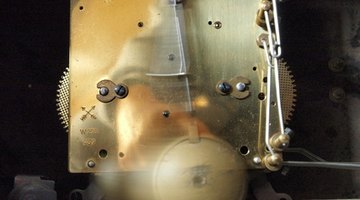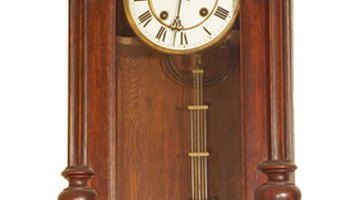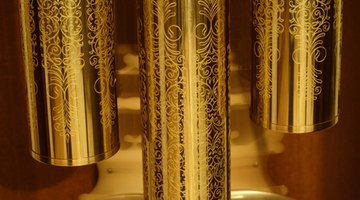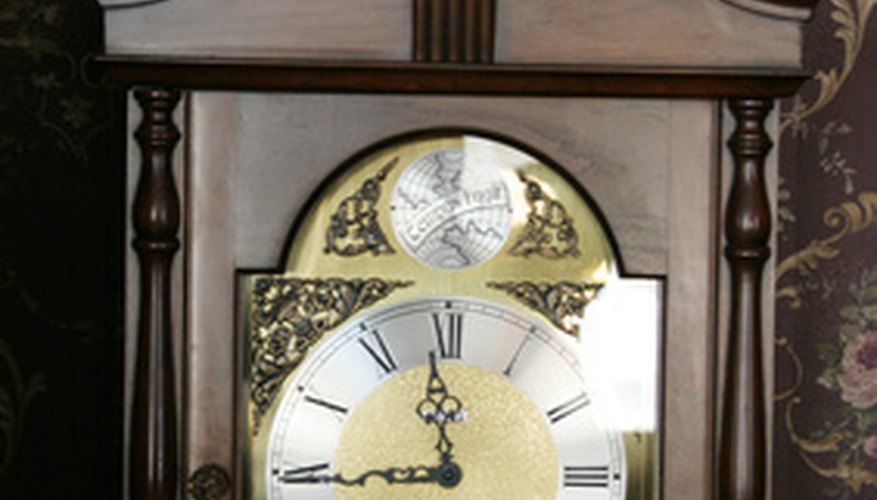Grandfather, grandmother and granddaughter clocks are all types of longcase clocks, which stand on the floor. A wooden case encloses the clock workings: the escapement--or clock movements--and the pendulum. In many styles, the clock movement and pendulum form decorative elements as well as being functional. Longcase clocks were among the earliest timepieces kept in the home for marking the passage of hours.
Clock Function

Clocks function by performing regular movements in equal intervals, which is linked to a counting mechanism. The counting mechanism records the number of movements. This same function occurs in all timepieces. The pendulum provides the movement, counting seconds; each swing of the arc equals one second of time. In longcase clocks, a pendulum must be 39 inches long in order to accurately count one second of time; longer or shorter pendulums change the time interval.
- Clocks function by performing regular movements in equal intervals, which is linked to a counting mechanism.
- The pendulum provides the movement, counting seconds; each swing of the arc equals one second of time.
History of the Grandfather Clock

The longcase clock did not appear until 1656, when Galileo discovered the pendulum's timekeeping properties and Christiaan Huygens provided the practical application of incorporating the pendulum into the timepiece. Huygens added a small weight to the pendulum to maintain the swinging momentum along with a mechanism to rewind the clock. This lifted the weight to its starting position and kept the pendulum moving.
- The longcase clock did not appear until 1656, when Galileo discovered the pendulum's timekeeping properties and Christiaan Huygens provided the practical application of incorporating the pendulum into the timepiece.
- Huygens added a small weight to the pendulum to maintain the swinging momentum along with a mechanism to rewind the clock.
The name "grandfather clock" was not applied to longcase clocks (also called tallcase clocks) until 1875, when Henry Clay Work composed a popular song--"My Grandfather's Clock"--in tribute to a tallcase clock standing in the George Hotel in North Yorkshire, England. The clock supposedly stopped and never ran again when the grandfather of the innkeeper died.
Types of Longcase Clocks

Longcase, or tallcase, clocks go by the names of grandfather, grandmother or granddaughter clocks. Each style holds the clock workings and pendulum with weights within a case. Antique clock cases were of high-quality woods, such as cherry and mahogany; contemporary cases come in glass, wood or a combination. The difference among the three styles lies in their size, age of production and overall quality.
- Longcase, or tallcase, clocks go by the names of grandfather, grandmother or granddaughter clocks.
- Antique clock cases were of high-quality woods, such as cherry and mahogany; contemporary cases come in glass, wood or a combination.
Grandfather Clocks

Grandfather clocks are the oldest and the largest of the three common types of longcase clocks, typically standing over six feet tall to a towering eight feet in height. The grandfather clock may appear very elaborate with an ornate clock face and pendulum, or look simpler in design. Grandfather clocks can hold significant antique value, depending upon the age, quality and condition of the piece. These are the most recognisable of the longcase clocks due to their distinctive size and structure.
- Grandfather clocks are the oldest and the largest of the three common types of longcase clocks, typically standing over six feet tall to a towering eight feet in height.
Grandmother and Granddaughter Clocks

Grandmother and granddaughter clocks are smaller versions of the grandfather clock. The grandmother clock stands between five and six feet tall, and appears much slimmer than a grandfather clock. It was first produced in the 1920s. Clock faces include scrolls and floral motifs, and appear more delicate than traditional grandfather clocks.
The granddaughter clock is much shorter than either the grandmother or the grandfather clock, with heights between three and five feet. The granddaughter clock was not produced until the 1930s. This style was generally constructed from inexpensive woods or veneers on plywood. Granddaughter clocks typically have silver-plated clock faces with painted numbers rather than the engraved faces appearing on grandfather clocks.
- Grandmother and granddaughter clocks are smaller versions of the grandfather clock.
- The granddaughter clock is much shorter than either the grandmother or the grandfather clock, with heights between three and five feet.
